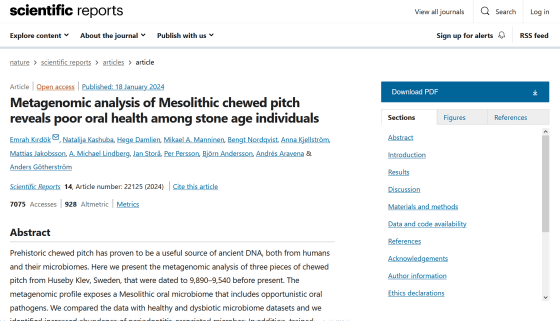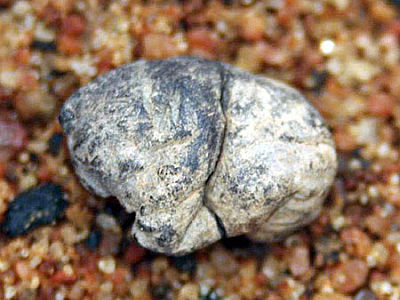Diseases and dietary habits of the time revealed from DNA left behind in ``gum chewed by young people in the Stone Age''

Many people chew gum when they feel lonely or want to wake up from sleep. In fact, people in the Stone Age also chewed resin as ``chewing gum,'' and by analyzing DNA collected from ancient gum, we are beginning to uncover the diseases and dietary habits of those days.
Metagenomic analysis of Mesolithic chewed pitch reveals poor oral health among stone age individuals | Scientific Reports
https://www.nature.com/articles/s41598-023-48762-6

DNA from stone age chewing gum sheds light on diet and disease in Scandinavia's ancient hunter-gatherers
https://theconversation.com/dna-from-stone-age-chewing-gum-sheds-light-on-diet-and-disease-in-scandinavias-ancient-hunter-gatherers-219620
Ancient 'chewing gum' sheds light on stone age teenagers' diet | Archaeology | The Guardian
https://www.theguardian.com/science/2024/jan/23/ancient-chewing-gum-stone-age-teenagers-diet
The Huseby Klev ruins in southwestern Sweden, excavated in the early 1990s, are Mesolithic ruins, just before Europeans began farming, and radiocarbon dating has dated them to between 10,200 and 9,400 years ago. I know it's a thing.
A total of 115 pieces of gum made of resin and birch bark were unearthed at the Hughesbeeclef site. These gums have distinct tooth impressions and are believed to have been used by stone tool cultures from the Mesolithic onwards as adhesives for assembling tools and weapons, or simply chewed for recreational or medicinal purposes. . Various gums with similar properties have been found around the world, such as coniferous resin and natural asphalt.

A research team led by
As a result of the analysis, half of the DNA extracted from the gum was of human origin, and although they were both male and female, most were from teenagers. On the other hand, the remaining DNA contained not only the microorganisms and fungi that lived in the expelled resin fragments, but also the substances that humans had chewed before the resin fragments, as well as DNA derived from microorganisms living in the mouth. thing.
Analyzing this DNA was a difficult task, but the research team used a variety of strategies to characterize the DNA, extract it, and piece together the fragmented DNA into longer pieces. They also used machine learning to analyze which microorganism or animal a specific DNA fragment belongs to.
As a result, traces of microorganisms commonly found in the oral microbiome, Streptococcus mutans , which causes dental caries, and the pathogen of Hib infection were also found. Although these pathogenic microorganisms were present at high frequencies, they did not exceed the range found in a healthy oral microbiome, and it is unclear whether the people who chewed these gums had the disease.
However, bacteria associated with periodontal disease, in which pathogens that invade between the teeth and gums cause inflammation and dissolve the bone that supports the teeth, have been found to exceed the levels found in healthy people. As a result of machine learning analysis, the research team concluded that the girl who bit the resin piece had a 75% chance of developing periodontal disease. Götherström commented, 'She probably started losing her teeth not long after the period when she started chewing gum.'

In addition, DNA from not only microorganisms but also large organisms such as red deer , brown trout , and hazelnuts was detected in the gum. These DNAs are likely traces of what the young people were eating before chewing gum.
However, because the DNA of eukaryotes, including these animals and plants, is larger and more complex, it is said to be less accurate than that of microorganisms, and it is possible that the DNA that appeared to be from brown trout may actually be from another fish. About. It is also said that fox DNA was found on the gum, but this suggests that the young people were actually eating foxes, or that the DNA was mixed in with the fox tendons and fur that they used for clothing. It is unclear whether the DNA may have adhered to the gum spit out when marking territory.
Götherström et al. said, 'This discovery is a major step toward understanding the fascinating record of Stone Age human culture. Further analysis may lead to even more surprising discoveries. No,” he commented.
Related Posts:
in Science, Posted by log1h_ik







